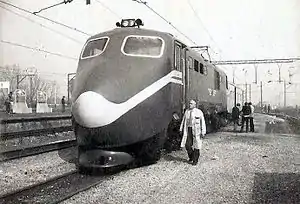Scheffel bogie
A Scheffel bogie is a flexible, high-stability radial bogie designed to reduce lateral force vibrations and accommodate turning on narrow gauge tracks at high speed. It first went into service in a fleet of South African Railway (SAR) ore wagons in 1975.[2][3] It is named after its inventor, Dr. Herbert Scheffel,[2] who designed the Scheffel bogie to facilitate the development of South Africa's 1,067 mm (3 ft 6 in) narrow-gauge railway system. The Scheffel bogie was used to set the world narrow gauge speed record of 245 kilometres per hour (152 mph) on Cape gauge tracks.[1]

South African Class 6E1, Series 4 unit no. E1525 with re-geared traction motors, Scheffel bogies, and a streamlined nose cone on the no. 1 end. In this configuration, no. E1525 reached a speed of 245 kilometres per hour (152 miles per hour), which remains the world narrow-gauge speed record.[1]
See also
References
- Coxon D. "Pantograph Testing in South Africa in 1980". Testing Trains. Retrieved 3 May 2019.
- Ball P (24 May 2016). "The Scheffel Bogie and the Rail Gauge". The Heritage Portal. Retrieved 3 May 2019.
- Bruton M (7 April 2011). "SA's Sheffel Bogie keeps on rolling". IOL. Retrieved 3 May 2019.
This article is issued from Wikipedia. The text is licensed under Creative Commons - Attribution - Sharealike. Additional terms may apply for the media files.